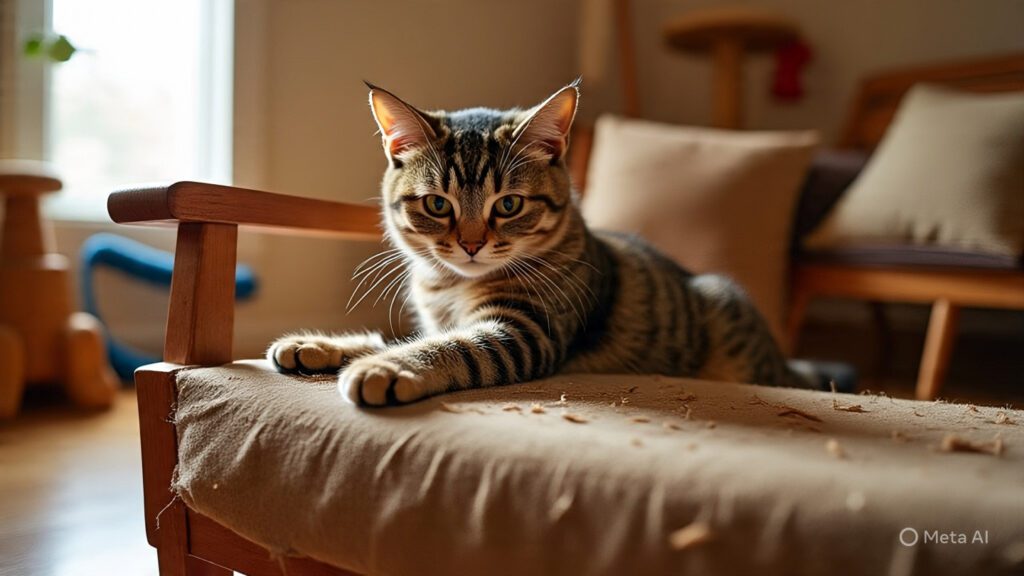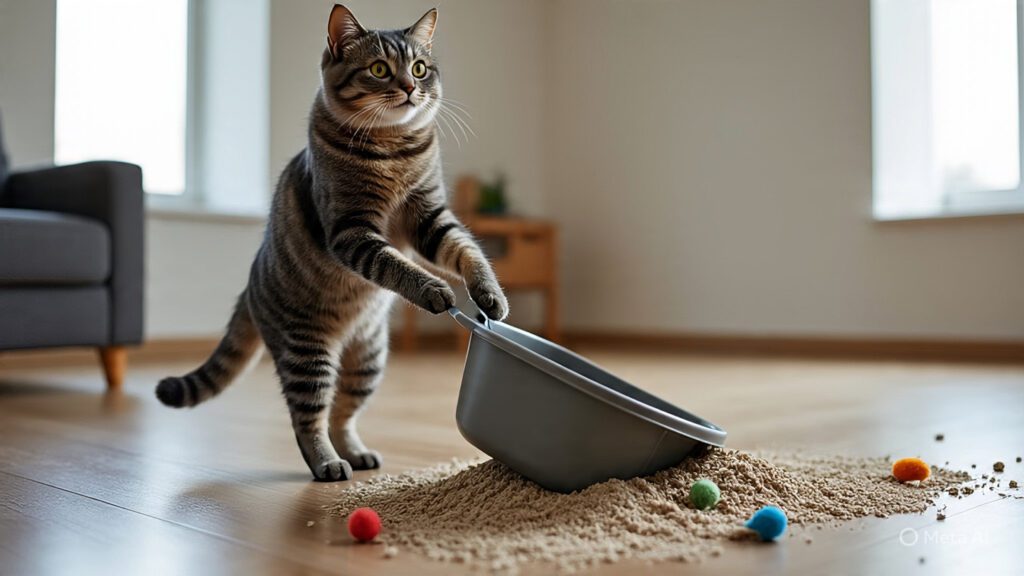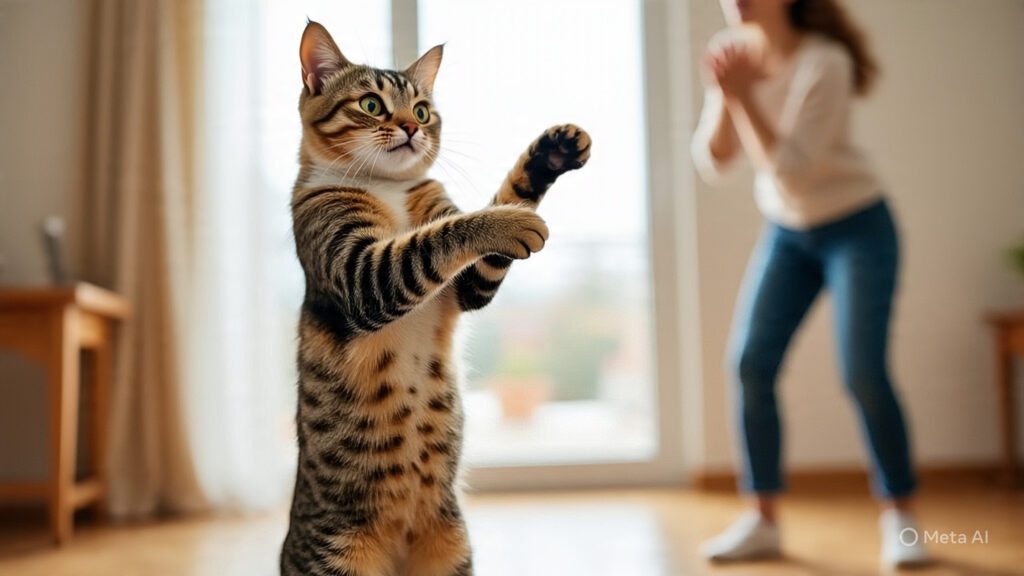Please Note: This post may contain affiliate links. If you click one of them, we may receive a commission at no extra cost to you. As an Amazon Associate, I earn from qualifying purchases.
Let's be honest: having a cat is like living with a small, fuzzy puzzle. One minute they're happily purring on your lap, and the next they're racing around the house like they've just eaten a whole bag of catnip.
But what do you do when their conduct is more confusing than cute? In this article, we'll talk about some frequent problems with cat behavior and how to deal with them directly.
Top Takeaways and Key Concepts
- Provide tall, stable scratching posts near furniture your cat likes to shred.
- Keep litter boxes clean, well-placed, and experiment with different litter types.
- Schedule regular playtime and feeding routines to reduce excessive meowing.
- Slowly introduce new pets or people, allowing controlled, positive interactions.
- Offer secure spaces, high perches, and hideaways to prevent aggression.
Article Summary
This article addresses common cat behavior issues and practical solutions. Scratching is natural, so provide appropriate posts made of sisal, wood, or cardboard and use positive reinforcement. Litter box problems often stem from cleanliness, location, or health issues, so maintain a clean box, try different litter, and consult a vet if problems persist. Excessive meowing can indicate anxiety or need for attention; structured playtime, feeding routines, and engaging toys help reduce it. Aggression toward other pets or people requires gradual introductions, safe spaces, and patience to encourage peaceful coexistence. Overall, understanding your cat’s instincts and providing proper outlets ensures a harmonious home for both pet and owner.
Video Summary
Handy Amazon Shopping Directory for Cat Supplies
Cat Food - Cat Toys - Cat Health - Grooming - Carriers - Cat Beds - Apparel
Furniture - Cat Doors - Collars - Feeding/Watering - Flea/Tick Control - Treats
Jump to Content
Scratching Furniture: The Cat's Way of Destroying Things

By the way, have you ever strolled into your living room and found that your favorite couch had become a scratching post?
There is fluff all over the place and claw marks that could be as big as those left by a bear! But before you start planning revenge on your cat, let's talk about why they scratch.
It's interesting that cats naturally scratch. It helps them maintain their claws sharp and healthy while also marking their territory with the smell glands in their paws.
So, when Fluffy scratches up your beloved chair, she's not trying to ruin your life; she's just being a cat! But I think we can all agree that there are better areas for her to show off her artistic skills.
If you want to stop your cat from scratching things they shouldn't, you need to buy high-quality scratching posts or pads that are made just for cats to love. Choose products made of sisal, cardboard, or natural wood, which are all materials that cats like to scratch. These textures not only fulfill your cat's natural need to scratch, but they also keep their claws healthy by stopping them from growing too long and lowering the danger of harm.
Think about how tall and stable the scratching post or pad is when you choose one. A taller post will let cats fully stretch their bodies while they scratch, something they enjoy to do. Also, making sure the post is strong enough to handle a lot of scratching will keep it from toppling over and making your cat not want to use it.
It's important to put these scratching surfaces near the furniture that your cat likes to shred. You could think of it as making an art exhibition particularly for them! You may channel their energy to the right places by putting the scratching posts near couches or chairs that they like to scratch. This not only keeps your furniture safe, but it also encourages good conduct.
Also, using positive reinforcement can be quite helpful in getting your cat to use her allocated scratching locations instead of more damaging ones. Give her snacks, praise her with words, or pet her when she comes near or utilizes the scratching post. This makes her think of the new scratching area in a good way and encourages her to keep utilizing it.
You could also want to try out other kinds of scratching surfaces and styles until you find one that your cat really likes. Some cats like vertical posts that they can climb on, while others like horizontal pads that are flat on the ground. Watching what she likes can provide you a lot of information about which choices are best for keeping her happy and entertained.
You might also add some interactive things near the scratching area, like toys or smells that smell good, to keep her from getting too interested in your furniture. This space will look better with a little ingenuity!
In the end, you need to be patient and consistent to stop bothersome scratching. You can keep your home safe and make it a joyful place for both you and your pet by giving them good choices and using positive reinforcement.
Problems With the Litter Box: When Nature Calls… Somewhere Else

Let's see, nothing ruins the mood like finding out that someone has turned your freshly cleaned floor into their own litter box. You're not the only one who has ever wondered why Mittens would go wild outside of her litter box.
There could be a lot of causes for this. It could be as basic as a dirty box (cats are quite finicky about cleanliness) or it could be in a bad position (who likes to do their business in a crowded hallway?).
Sometimes, a cat won't use the litter box because it's stressed or has a health problem, such a urinary tract infection (UTI). Dealing with unexpected surprises can be quite stressful for you and your cat. You need to be understanding and careful in this case.
First and foremost, make sure the litter box is always spotless. Cats are inherently picky, and a litter box that isn't clean can keep them from using it. To keep your cat's space inviting, you should scoop the litter box every day and clean it thoroughly every week. Also, think about where to put the litter box. It should be in a peaceful, low-traffic area where your cat can do her business without being disturbed.
It's also important to try out different kinds of litter because every cat is different. Some cats may like clumping clay litters better since they feel familiar and make it easy to dig and hide up waste. Some people might like crystal litters that soak up moisture well without clumping, although their texture can make them less appealing at times. Pet owners who care about the environment might also be interested in biodegradable options produced from things like corn or recycled paper. However, it's important to remember that not all cats will prefer these alternatives right immediately.
If you've cleaned the litter box and tried several types of litter but your cat still won't use it, pay attention to any other strange things she could be doing. If your pet is peeing outside the box a lot, having trouble peeing, having blood in their urine, or grooming too much around their genitals, these could be signs of major health problems that need to be looked at by a vet right away.
If this happens, don't put off going to the vet. A professional exam is very important for finding possible health problems that could change her behavior, like urinary tract infections or other illnesses. Your vet may suggest tests or treatments that are specifically designed for your cat's needs.
As an owner, you will need to be patient and watchful in order to deal with your pet's dislike of the litter box. By keeping her space clean and safe and looking into different types of litter, you're taking measures to fix any problems she might be having. And if she needs medical help, you'll be able to relax knowing that you did the right thing for her health!
Too Much Meowing: Is Your Cat Trying to Tell You Something?

Let's move on to the fun task of meowing! I can see why they want to talk to me when they feel like it, but when my cat meows instead of purring, I have to wonder if she thinks she's good enough to be on America's Next Idol.
One noteworthy thing to note in all of these cases is that part of that carrying can be caused by anxiety or other strong emotions.
Cats are naturally gregarious and like being around people, so they will want your attention.
If your cat can't get your attention while you're out running errands or shopping, they will probably let you know how they feel by making noises, such whining or meowing. Pet owners can get very angry when their pets do this, but it's important to know what makes them do it in order to find ways to stop it. Every good plan should either fix a specific issue or make some aspects of your cat's behavior less painful.
To fix this problem, you need to first find out what caused it and then deal with it. Cats are sociable animals who need interaction and stimulation to be happy. So, setting up regular playtime can make them feel much better. During these special times, keep them busy with fun toys like feather wands, laser pointers, or interactive puzzle feeders that not only keep them interested but also get them moving. This not only helps them use their energy in a good way, but it also makes your bond with your cat stronger.
Setting a regular feeding plan might also help your cat understand when to expect meals. Feeding them at the same time every day helps them learn when to expect their next meal. It's important to remember that cats can still beg for food outside of these planned times because they are opportunistic eaters. However, maintaining a pattern makes sure that you have given them enough and eases some of the stress that comes with not knowing when their next meal will be.
Also, giving your child interactive toys and activities to do while they play will help them feel less bored or lonely when you're not home. To keep your cat interested, think about changing their toys often. Even small changes can make a great impact in keeping their interest.
Finally, if your cat keeps whining too much or showing signs of distress when left alone even after you try these strategies, it might be a good idea to look into other options, like environmental enrichment techniques or even talking to a veterinarian or animal behaviorist for more ideas on how to deal with any behavioral problems.
Setting up playing and feeding schedules are two examples of proactive efforts you can take to make your home a better place for both you and your cat. This will make your cat happier because she will know that her wants will be addressed.
Being Nasty to Other Pets or People

Sometimes our tiny fur balls act like they're trying to get into an action movie by being rude to people and other pets. You should be ready for the worst if you were scratched by cats while you thought you were patting them affectionately.
Cats that act aggressively out of fear or the need to protect their territory are not trying to hurt anyone. This is an important difference because knowing what caused this behavior might help cat owners deal with it better. For example, a cat may feel threatened and respond aggressively when a new pet or an unusual guest enters what it thinks is its territory. After all, every cat thinks of its house as a peaceful castle that needs to be protected!
To get through these potentially unpleasant circumstances, it's important for owners to be patient and empathetic while introducing new people. Cats are creatures of habit and regularity. They do best in places where they feel safe. So, it's important to give them enough time to become used to new people. Every cat has its own speed at which it gets used to changes in its surroundings.
One good way to do this is to let the resident cat and the new cat (or person) get to know one other slowly. Instead of making them meet face-to-face right away, think about splitting up the spaces where they can connect without getting too much in each other's way. At first, you might want to keep them in separate rooms so they can become used to each other's smells through closed doors or by switching bedding.
You may gently increase the amount of time they spend together while keeping a close eye on how they behave as they get used to each other. Giving each other food and praise throughout these exchanges can also help them think of one other in a better way. You can help your cats get along by making sure they have fun times together, such playing or eating together. This will make them think of each other as wonderful things instead of stress.
It's also crucial to give each cat a secure place to go if they start to feel too much. During this time of change, both cats can control their surroundings by having high perches, warm hideaways, or even “safe zones.”
If you start slowly and respect each cat's comfort level, they will be able to live together peacefully. Over time, once they understand that the newcomer isn't a threat and maybe even find something they both want to do, like playing together, their relationship will probably grow into one of friendship instead of competition.
To sum up, it's important to be patient and make smart introductions when you bring new dogs into your home. By recognizing and carefully managing interactions, you can make a space where both your current cat and any future cats may live together peacefully. This will turn any worry into friendliness!
Suggested Resources:
Understanding Cat Behavior
https://www.aspca.org/pet-care/cat-care/common-cat-behavior-issues
How To Stop Your Cat from Scratching Furniture
https://www.humanesociety.org/resources/how-stop-your-cat-scratching-furniture
Litter Box Solutions
https://www.cattime.com/cat-facts/litter-box-solutions
Frequently Asked Questions
Why does my cat scratch furniture?
Cats scratch to mark territory, keep claws healthy, and stretch their bodies. Providing tall sisal, wood, or cardboard posts near targeted furniture helps redirect the behavior.
How can I stop my cat from scratching the wrong areas?
Give appealing scratching posts, place them near favorite furniture, and reward your cat when they use them. Positive reinforcement builds lasting habits.
Why is my cat avoiding the litter box?
A dirty box, poor location, or unsatisfactory litter texture can cause avoidance. Health issues like UTIs should be considered if behavior continues.
How do I fix litter box issues?
Keep boxes clean, place them in quiet areas, and try different litter types. If no improvement occurs, consult a vet to rule out medical concerns.
Why does my cat meow excessively?
Excessive meowing can be triggered by anxiety, boredom, or attention seeking. Scheduled playtime, feeding routines, and mental stimulation help reduce vocalization.
What should I do if my cat is aggressive toward people or other pets?
Slow introductions, scent swapping, and supervised interactions help reduce fear-based aggression. Provide safe spaces and allow time for gradual adjustment.
Do environmental changes help manage behavior problems?
Yes, adding high perches, hideaways, toys, and structured enrichment reduces stress and encourages positive behavior patterns.

Kevin Collier is a dedicated feline enthusiast and expert contributor at CatFAQ.com, where he shares his knowledge on cat health, training, and overall well-being. With years of experience caring for and studying cats, Kevin provides insightful tips and practical advice to help cat owners nurture and understand their pets better. His passion for enhancing the human-animal bond shines through in his articles, making them a valuable resource for anyone looking to improve their cat’s quality of life. Whether it’s training techniques or health care tips, Kevin aims to empower cat owners with the information they need to ensure their furry companions thrive.

